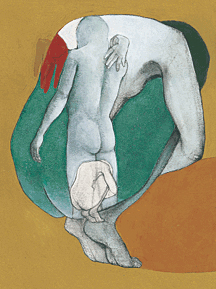
Scar tissue is one of the body’s responses to injury. In certain cases, it can also be an impediment to healing.
“The question is: Is the response an over-response?” Dr. Ellen Heber-Katz was asking. “Does the animal really have to scar to the extent it does to cover over a wound?”
For Heber-Katz, an immunologist at the Wistar Institute, the question was both rhetorical and highly practical. She and a team of researchers at Wistar recently demonstrated that when they cut the spinal cord of a mouse but limited the formation of scar tissue at the site, the cord was able to heal. Neurons on both sides of the injury were able to grow and reestablish connections with each other, and within three weeks, the mouse was up and walking around.
“We believe that the scar is presenting a physical barrier” to regeneration, said Heber-Katz, who is also an adjunct professor in pathology and laboratory medicine in the School of Medicine. “It could also be a chemical barrier. But it clearly is a physical barrier.”
Scar tissue is tough stuff, she says. “It’s like a bullet-proof vest.” If it’s not present at the injury, “you get this incredible axonal growth, and animals do recover and walk again. The animals are 75-80 percent normal within three weeks.”
Heber-Katz’s team made two types of injuries in mice. The first involved a complete transectional cutting through the spinal cord, including the dura—the outer layer of protective membranes that encloses the cord. That injury turned out to be permanent.
The other injury involved cutting the cord but not the dura. While the latter bit of “surgical manipulation” was “difficult,” she allows, enough of the dura was left to keep the two ends of the cord close together and stable. It also had the effect of blocking inflammatory cells from the injury site. As a result, she says, “there was no—or very little—scarring.”
As an immunologist, Heber-Katz came to study spinal-cord injuries “out of left field,” in her words. While studying a special strain of mouse that “spontaneously gets auto-immune disease, a form of lupus,” she noticed something unusual. Three weeks after punching holes in the ears of those mice, the holes—including skin, hair, and cartilage—had completely healed. [“Going Where Science Leads,” March/April 2001.] That led her to study the regenerative abilities of the heart and other organ systems, and ultimately to the spinal cord.
Heber-Katz’s team at Wistar included Dr. Alexander Seitz, a postdoctoral fellow, and Elsa Aglow; their findings were first published in the February 1 issue of the Journal of Neuroscience Research. They raise the possibility that recovery from severe spinal-cord injury may be possible not only if the scarring process is prevented, but also if scar tissue can be eliminated after it has formed.
Since the article was published, she says, several pharmaceutical companies have offered to let her test different therapeutic molecules to prevent scarring. “If we can find the molecule that can block scarring and allow or accelerate regeneration,” says Heber-Katz, “then I consider it a great success.”



